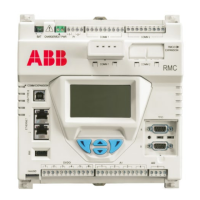22 | RMC-100| 2105552MNAE
Table 2-9 provides the digital input and output specifications. For specific pinout information, see
section 3.5.5.4, Digital input and output pinouts.
Table 2-9: Digital input and output specifications
Electrical specification
(each point)
Voltage range for both input and output modes
DI Vlow threshold
Maximum voltage threshold for detecting a closed
input configurable in system
configurable
DI Vhigh threshold
Minimum voltage threshold for detecting an open
input configurable in system
configurable
DI Vpullup
Open circuit voltage on input with DI 10 K pull-up
enabled
3.4 Vdc +/- 0.3 Vdc
DI Iminsink
Minimum external sinking current required to
detect closed input with DI 10 kΩ pull-up enabled
0.2 mA
Input impedance to GND of DI/DO with DO open
DI/DO Ileakage
Short circuit leakage current with DI 10 kΩ pull-up
enabled
450 µA typical
DI/DO shielding
Shielded signal pairs, shielded to prevent spurious
signals
Not applicable
DI/DO Vtvs
Each DI/DO point has onboard TVS protection,
typical V threshold level to begin conducting.
32 Vdc typical
Maximum continuous sink current
Max on resistance of MOSFET OD output to GND
2.2.4 TFIO expansion interfaces
The RMC provides expansion interfaces to add modular I/O. The RMC has two TFIO interfaces, TFIO A
and TFIO B. Each TFIO interface supports up to 22 TFIO modules (44 total).
The RMC uses two independent buses to communicate with the modules. ABB Totalflow devices have
an I/O protocol to exchange information with the modules. The buses operate in a master/slave
mode, with the main device board acting as master.
The TFIO modules are DIN rail mountable and employ contact technology for field wiring. The modules
interconnect with each other to provide the necessary power and interface signals along the bus.
The RMC does not support the TFIO CIM module. The RMC supports the
modules labeled for use with 24 Vdc.
All modules have four LED lights, a manual reset button, and a selectable address from zero through
seven (Figure 2-9
). On the faceplate of each module is:
– Type of module
– LED light panel
– Reset button
– Module address selector
For additional information, refer to the TFIO Module User Manual. See Additional information
for a link
to the manual.

